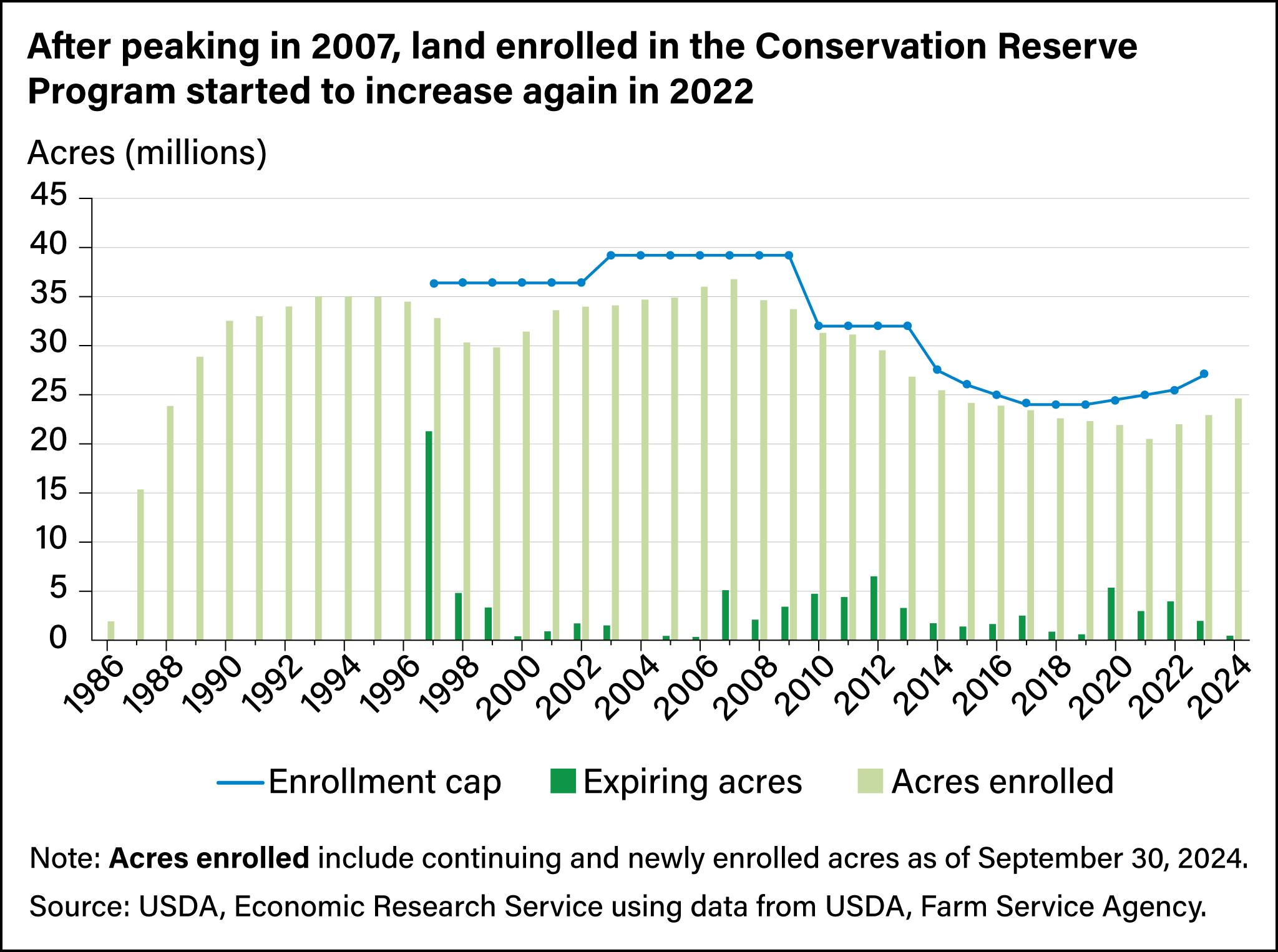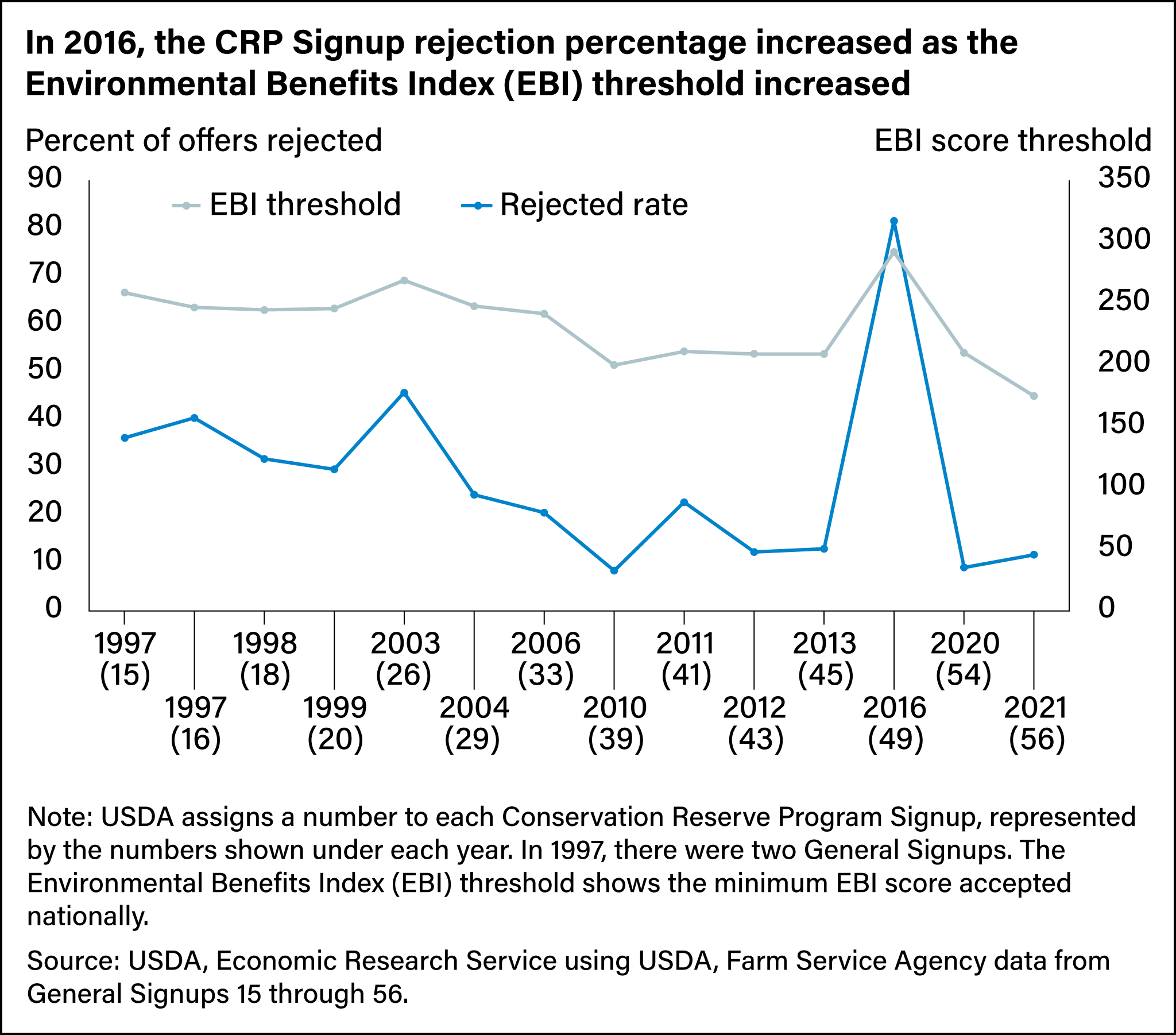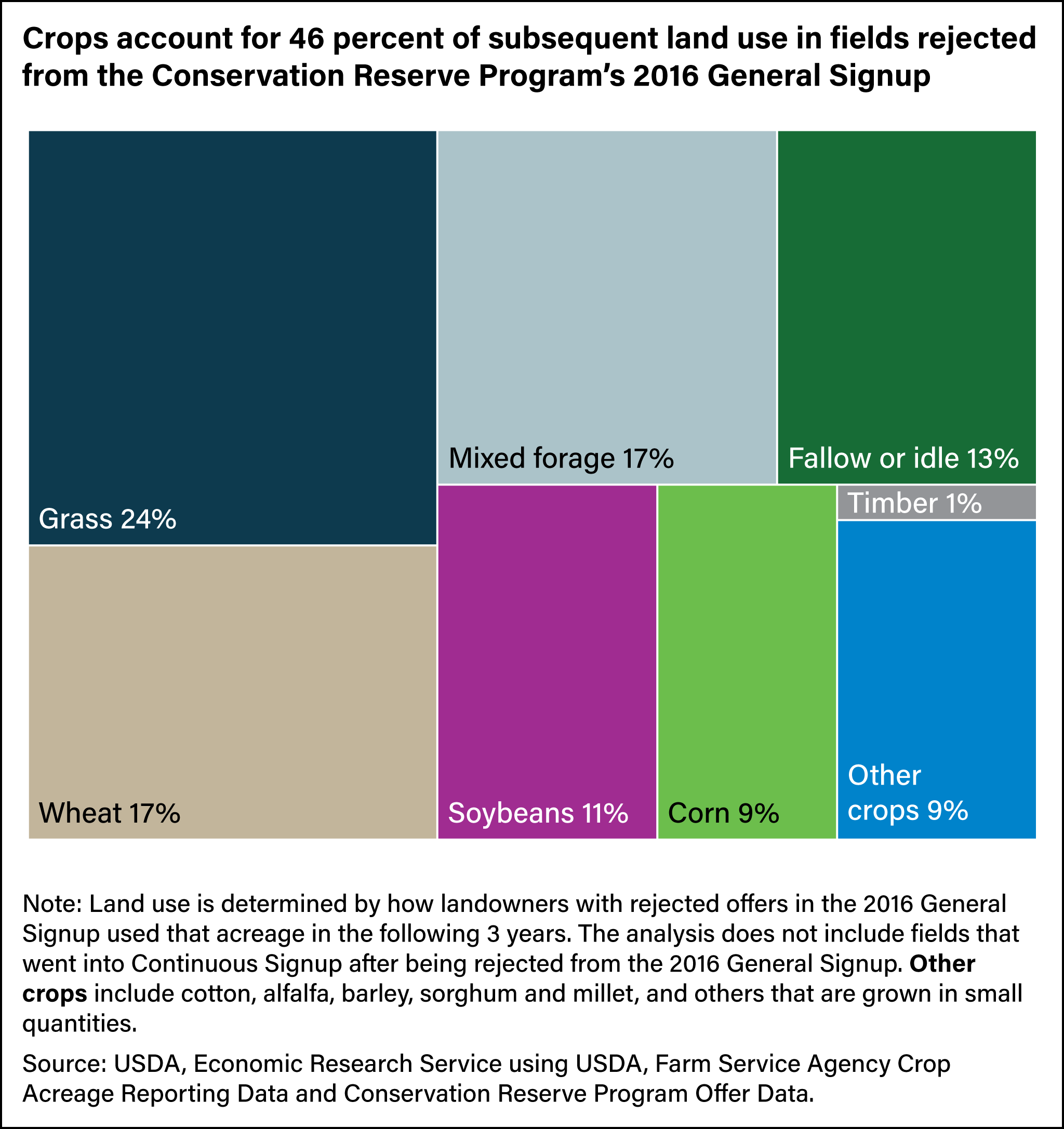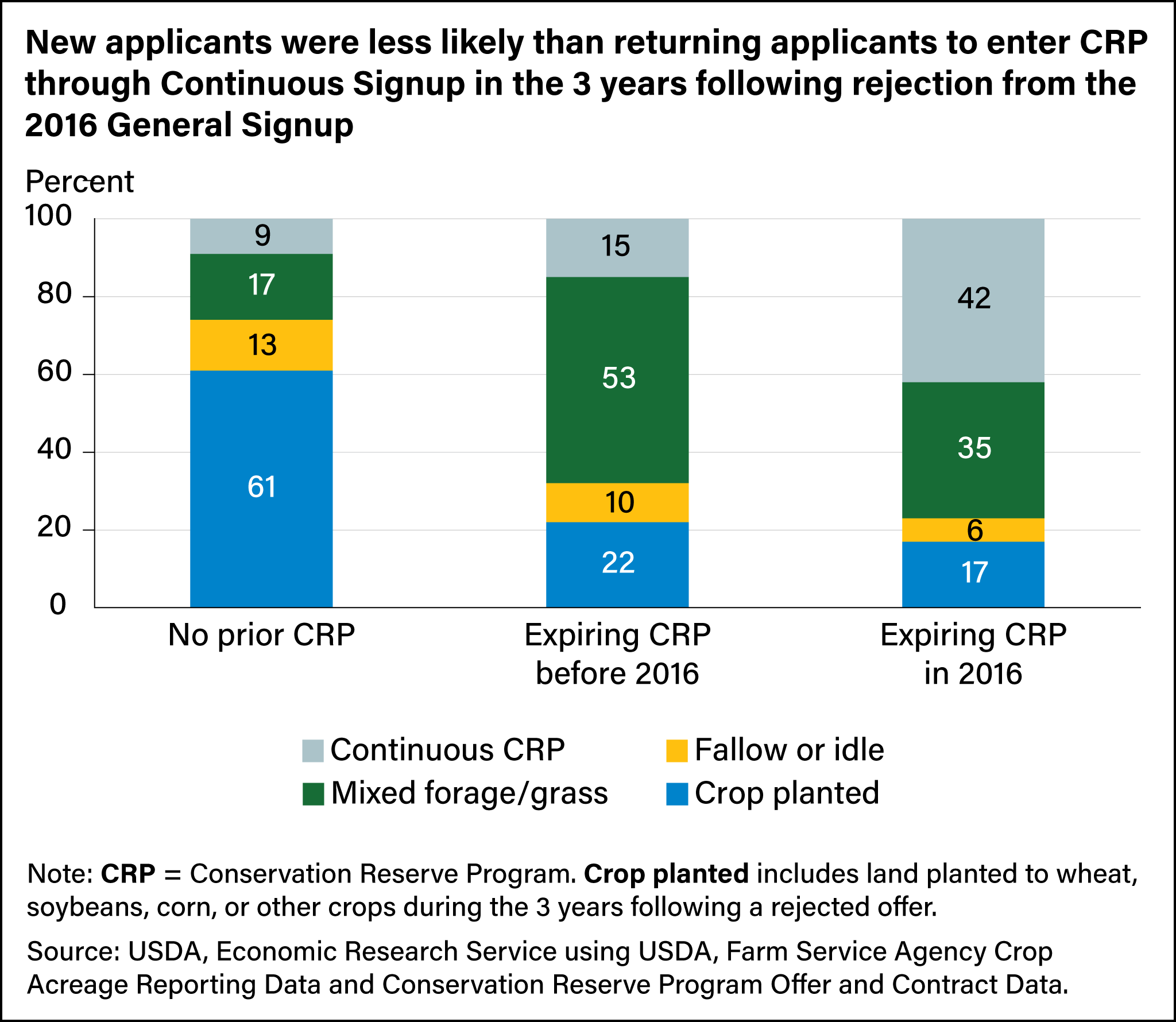
What happened to land rejected from the Conservation Reserve Program? An analysis of the 2016 General Signup
- by Andrew B. Rosenberg and Bryan Pratt
- 4/8/2025
Highlights
- The Conservation Reserve Program (CRP) enrolls highly erodible and other environmentally sensitive acreage to vegetative cover to improve water quality, control soil erosion, and enhance wildlife habitat. Acreage is split among three subprograms: General Signup (involving a competitive bidding process), Continuous Signup, and Grassland CRP.
- The 2016 CRP General Signup had an unusually high rejection rate of 82 percent, compared with other years in which offers were rejected at rates below 50 percent. Many of these rejected offers probably would have been accepted in other General Signups.
- Nearly half the rejected CRP acres that did not subsequently enter CRP through Continuous Signup went into row-crop production (primarily corn, soybeans, and wheat). Other, less intensive land uses included grass (24 percent), mixed forage (17 percent), and land left fallow (13 percent).
- Landowners with expiring CRP contracts were more likely to put their land in grass or mixed forage after their offer was rejected or re-enroll through Continuous Signup, but new applicants who were rejected were more likely to turn to crops.
As USDA’s largest land retirement program, the Conservation Reserve Program (CRP) pays landowners a yearly rental fee to convert highly erodible or otherwise environmentally sensitive land to vegetative cover such as native grasses. The program aims to achieve environmental benefits such as improving air and water quality, providing wildlife habitat, and sequestering carbon through land-use change. Contracts typically range from 10 to 15 years.
To better understand the environmental effects of CRP, researchers with USDA, Economic Research Service (ERS) examined how landowners used land that had been offered to the program but was rejected. Some offers, often those with low environmental benefits or high enrollment costs, are rejected, and what landowners decide to do with their rejected land can show which land uses CRP displaces when offers are accepted. Researchers also analyzed how land-use decisions differ between returning and new applicants.
Conservation Reserve Program Background
CRP was established as part of the 1985 Farm Bill and is administered by USDA’s Farm Service Agency (FSA). CRP reached peak enrollment in 2007 when 36.8 million acres were in the program. As of September 2024, nationwide CRP enrollment stands slightly below 25 million acres, which is close to the program’s cap of 27 million acres for 2023.

CRP includes three enrollment options:
- The General Signup: FSA ranks producer-submitted offers based on environmental benefits. The General Signup includes a competitive auction enrollment mechanism.
- The Continuous Signup: always open but has more stringent eligibility requirements and typically enrolls a different set of conservation land covers. Continuous Signup includes many initiatives with specific emphases, such as Clean Lakes Estuaries and Rivers, State Acres for Wildlife Enhancement, or partnerships with State agencies under the Conservation Reserve Enhancement Program.
- Grassland CRP: maintains land in grasses, as opposed to the other Signups, which require a history of crop cultivation. Grassland CRP has been increasing in acreage the last few years. Grassland signup is a working land program.
The General Signup is the longest-standing component of CRP. Through the General Signup, producers submit offers to FSA that include land-cover practices they plan to establish (such as grasses or wildlife habitat) and a proposed per acre rental rate. FSA then evaluates these offers based on estimated environmental benefits and assigns a score using the Environmental Benefits Index. Land parcels with higher index scores are more likely to be accepted. Historically, the General Signup has accounted for most of the acres enrolled in the CRP. In 2008, the General Signup accounted for 31 million of the 35 million acres enrolled in CRP. In recent years, other CRP options such as the Continuous Signup and Grasslands CRP have become more prominent. As of September 2024, around 8 million of the 25 million acres enrolled entered CRP through the General Signup.
The 2016 General Signup and Post-Rejection Land Use
ERS researchers identified the 2016 General Signup as uniquely useful for studying what happens when FSA rejects a landowner’s offer. This Signup had an unusually high rejection rate of 82 percent, compared with less than 50 percent in the preceding or subsequent years. The CRP General Signup determines which offers are accepted based on a signup-specific threshold for the Environmental Benefits Index (EBI). The EBI awards points for various environmental benefits from a particular offered parcel—including water quality benefits, erosion reduction, and wildlife habitat obtained, among others—weighed against the offered rental rate. In 2016, the General Signup set the EBI threshold at 292. Before 2016, the highest cutoff had been 269 in 2003.

Producer offers in 2016 were similar to those in other General Signups in terms of Environmental Benefits Index scores and other measurable features, and many of the offers rejected in 2016 probably would have been accepted in previous or subsequent General Signups with lower rejection rates. Thus, a large portion of land that was rejected in 2016 and subsequently put into productive uses would have been in CRP land covers had it been offered in previous or subsequent General Signups. With that in mind, ERS researchers examined the land-use records of 33,629 fields rejected in the 2016 General Signup to determine how the land was used over the next 3 years until the next General Signup in 2020. They estimated that almost half of rejected General Signup CRP acres that did not subsequently enroll in Continuous CRP were put into row-crop production (primarily for corn, soybeans, and wheat), 24 percent in grass, 17 percent in mixed forage (a mix of forage crops that may or may not include a grass), and 13 percent left fallow.

Differences Between New and Returning Applicants
ERS researchers also examined how land-use decisions differed for new CRP applicants (those applying to the 2016 General Signup without prior land in CRP) and returning CRP applicants. The chart below shows the average post-2016 land uses (from 2017 through 2019) of rejected offers conditioned on prior land use. The left column shows the land-use decisions made by new applicants for the 2016 Signup. The second and third columns show land uses for returning applicants, for the 2016 Signup, including uses by landowners with CRP land expiring sometime before the 2016 Signup or in 2016. New applicants were less likely to enter CRP through Continuous Signup between 2017 through 2019, after being rejected from the 2016 General Signup than either group of returning applicants (9 percent of the rejected land vs. 15 percent and 42 percent). Returning applicants also tended to keep their land in grass or mixed forage, suggesting they were more likely to keep their land in less intensive uses after leaving the program, at least in the immediate years afterward.

These differences in land-use choices may lead to different environmental benefits depending on whether the enrolled land was offered by new or returning applicants. However, these differences will depend on the specific benefits considered. For example, land that has never been in CRP often is used for intensively farmed cropland, so enrollment can help displace high-intensity farming and improve environmental outcomes. This might be useful if the goal of the CRP program is to maximize the amount of cropland displaced per dollar spent. On the other hand, if the goal is to obtain environmental benefits that require a longer time frame to be realized, such as wildlife habitat, then enrolling returning land, which may have been used less intensively for grasses, may be more useful for policymakers.
This article is drawn from:
- Rosenberg, A.B., Pratt, B., Arnold, D. & Williams, R. (2024). Land Use of Rejected, Enrolled, and Expiring Fields in the Conservation Reserve Program. U.S. Department of Agriculture, Economic Research Service. EIB-276.
You may also like:
- Bigelow, D. & Hellerstein, D. (2020, February 3). In Recent Years, Most Expiring Land in the Conservation Reserve Program Returned to Crop Production. Amber Waves, U.S. Department of Agriculture, Economic Research Service.
- Conservation Programs. (n.d.). U.S. Department of Agriculture, Economic Research Service.
- Bigelow, D., Claassen, R., Hellerstein, D., Breneman, V., Williams, R. & You, C. (2020). The Fate of Land in Expiring Conservation Reserve Program Contracts, 2013-16. U.S. Department of Agriculture, Economic Research Service. EIB-215.
- Pratt, B. & Wallander, S. (2022). Cover Practice Definitions and Incentives in the Conservation Reserve Program. U.S. Department of Agriculture, Economic Research Service. EIB-233.
- Rosenberg, A.B. & Pratt, B. (2023). Land use impacts of the Conservation Reserve Program: An analysis of rejected offers. American Journal of Agricultural Economics. 106(3), 1217–1240.

